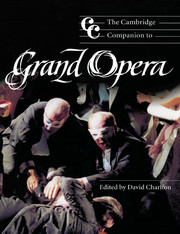Book contents
- Frontmatter
- 1 Introduction
- Part I The resourcing of grand opera
- 2 The ‘machine’ and the state
- 3 Fictions and librettos
- 4 The spectacle of the past in grand opera
- 5 The chorus
- 6 Dance and dancers
- 7 Roles, reputations, shadows: singers at the Opéra, 1828–1849
- Part II Revaluation and the twenty-first century
- Part III Grand operas for Paris
- Part IV Transformations of grand opera
- Notes
- Select bibliography
- Index
3 - Fictions and librettos
from Part I - The resourcing of grand opera
Published online by Cambridge University Press: 28 November 2011
- Frontmatter
- 1 Introduction
- Part I The resourcing of grand opera
- 2 The ‘machine’ and the state
- 3 Fictions and librettos
- 4 The spectacle of the past in grand opera
- 5 The chorus
- 6 Dance and dancers
- 7 Roles, reputations, shadows: singers at the Opéra, 1828–1849
- Part II Revaluation and the twenty-first century
- Part III Grand operas for Paris
- Part IV Transformations of grand opera
- Notes
- Select bibliography
- Index
Summary
The verses which the librettist writes ... are really a private letter to the composer ... They must efface themselves and cease to care what happens to them.
It is a cliché to observe that opera, and perhaps in particular grand opera, is a composite venture, and that it is from this very hybridity that its strengths are fashioned. One need only peruse the range of ‘resources’ discussed in Part I of this Companion to see that grand opera generates a form of cultural force-field in which otherwise disparate skills are focused in the service of a particular production (and a particular product which hopes to exceed the proverbial sum of its parts). If this is true of performance arts in general, then to the theatrical arts here we must add the musical faculties of orchestration and singing. Indeed, it is hard to resist the sense that these faculties are at the core of a cultural product to which the visual and the textual contribute but which they do not dominate.
One can imagine how the story of the relationship between grand opera and its textual complement, the libretto, might be idealised as a harmonious marriage of equal partners; purely aesthetic criticism would explore how the libretto supports or underpins the project of staging a particular opera. It would, however, probably be a mistake to claim that it is largely in such textual frameworks where we find the most conspicuous innovations of grand opera, innovations which might lead us to recall, for more than purely historical reasons, the merits of an essentially nineteenth-century genre as the twenty-first begins.
- Type
- Chapter
- Information
- The Cambridge Companion to Grand Opera , pp. 43 - 57Publisher: Cambridge University PressPrint publication year: 2003



